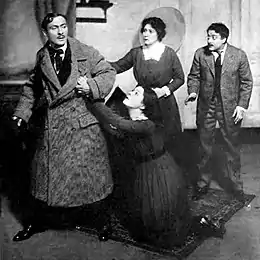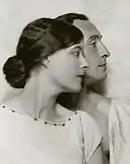Lionel Atwill
Lionel Alfred William Atwill (1 March 1885 – 22 April 1946) was an English stage and screen actor. He began his acting career at the Garrick Theatre. After coming to the U.S., he subsequently appeared in various Broadway plays and Hollywood films. Some of his more significant roles were in Captain Blood (1935), Son of Frankenstein (1939) and To Be or Not to Be (1942).
Lionel Atwill | |
|---|---|
 Atwill in 1921 as Deburau | |
| Born | Lionel Alfred William Atwill 1 March 1885 Croydon, England |
| Died | 22 April 1946 (aged 61) Pacific Palisades, Los Angeles, California, U.S. |
| Occupation | Actor |
| Years active | 1904–1946 |
| Spouses | Phyllis Relph
(m. 1913; div. 1919)Mary Paula Pruter (m. 1944) |
| Children | 2 |
Life and career

Atwill was born on 1 March 1885 in Croydon, London, England. He studied architecture before his stage debut at the Garrick Theatre, London, in 1904.[1]

He became a star in Broadway theatre by 1918 and made his screen debut in 1919.[2] His Broadway credits include The Lodger (1916), The Silent Witness (1930), Fioretta (1928), The Outsider (1924), Napoleon (1927), The Thief (1926), Slaves All (1926), Beau Gallant (1925), Caesar and Cleopatra (1924), The Outsider (1923), The Comedian (1922), The Grand Duke (1921), Deburau (1920), Tiger! Tiger! (1918), Another Man's Shoes (1918), A Doll's House (1917), Hedda Gabler (1917), The Wild Duck (1917), The Indestructible Wife (1917), L'elevation (1917), and Eve's Daughter (1917).[3]
He acted on the stage in Australia and then became involved in U.S. horror films in the 1930s, including leading roles in Doctor X (1932), The Vampire Bat, Murders in the Zoo and Mystery of the Wax Museum (all 1933), and perhaps most memorably as the one-armed Inspector Krogh in Son of Frankenstein (1939), [1] a role famously parodied by Kenneth Mars in Mel Brooks' 1974 satire Young Frankenstein. He appeared in four subsequent Universal Frankenstein films as well as many other of the studio's beloved chillers.
His other roles include a romantic lead opposite Marlene Dietrich in Josef von Sternberg's The Devil Is a Woman (1935), a crooked insurance investigator in The Wrong Road (1937) for RKO, Dr. James Mortimer in 20th Century Fox's film version of The Hound of the Baskervilles (1939), and Professor Moriarty in the Universal Studios film Sherlock Holmes and the Secret Weapon (1943).[1] He also had a rare comedy role in Ernst Lubitsch's 1942 classic To Be or Not to Be and that same year menaced Abbott and Costello in Pardon My Sarong.

Personal life

Atwill married four times. His first wife was Phyllis Ralph; the couple married in 1913 and divorced in 1919. In 1941, their son John Arthur Atwill (born 1914) was killed in action at age 26.[4] Atwill married the actress Elsie Mackay in 1920. He married Louise Cromwell Brooks in 1930 after her divorce from General of the Army Douglas MacArthur; they divorced in 1943.[5] Atwill married Paula Pruter in 1944, and their marriage continued until his death.[1] Their son, Lionel Anthony Atwill, is a retired writer.
In 1942, Atwill was indicted for perjury by a jury investigating the 1941 proceeding of a grand jury relative to the alleged occurrence of a sex orgy at his home. He was given five years probation, but Hollywood producers and other executives blacklisted him for minor criminal activity. He made small film appearances afterward.[6][7]
Atwill died on 22 April 1946, as a result of lung cancer[8] and pneumonia at his home in Pacific Palisades, Los Angeles.[1]
Filmography
- Eve's Daughter (1918) - Courtenay Urquhart
- For Sale (1918) - Minor Role
- The Marriage Price (1919) - Kenneth Gordon
- The Eternal Mother (1920) - Howard Hollister
- The Highest Bidder (1921) - Lester
- The Silent Witness (1932) - Sir Austin Howard
- Doctor X (1932) - Dr. Jerry Xavier
- The Vampire Bat (1933) - Dr. Otto von Niemann
- The Secret of Madame Blanche (1933) - Aubrey St. John
- Mystery of the Wax Museum (1933) - Ivan Igor
- Murders in the Zoo (1933) - Eric Gorman
- The Sphinx (1933) - Jerome Breen
- The Song of Songs (1933) - Baron von Merzbach
- Secret of the Blue Room (1933) - Robert von Helldorf
- The Solitaire Man (1933) - Inspector Wallace
- Nana (1934) - Colonel André Muffat
- Beggars in Ermine (1934) - John 'Flint' Dawson aka John Daniels
- Stamboul Quest (1934) - Herr Von Sturm
- One More River (1934) - Brough
- The Age of Innocence (1934) - Julius Beaufort
- The Firebird (1934) - John Pointer
- The Man Who Reclaimed His Head (1934) - Henry Dumont
- The Devil Is a Woman (1935) - Capt. Don Pasqual 'Pasqualito' Costelar
- Mark of the Vampire (1935) - Inspector Neumann
- The Murder Man (1935) - Captain Cole
- Rendezvous (1935) - Major William Brennan
- Captain Blood (1935) - Colonel Bishop
- Lady of Secrets (1936) - Mr. Whittaker
- Till We Meet Again (1936) - Ludwig
- Absolute Quiet (1936) - G.A. Axton
- The High Command (1937) - Maj. Gen. Sir John Sangye, VC
- The Road Back (1937) - Prosecutor
- The Last Train from Madrid (1937) - Col. Vigo
- Lancer Spy (1937) - Colonel Fenwick
- The Wrong Road (1937) - Mike Roberts
- The Great Garrick (1937) - Beaumarchais
- Three Comrades (1938) - Breuer
- The Great Waltz (1938) - Count Hohenfried
- Son of Frankenstein (1939) - Inspector Krogh
- The Three Musketeers (1939) - De Rochefort
- The Hound of the Baskervilles (1939) - James Mortimer M.D.
- The Gorilla (1939) - Walter Stevens
- The Sun Never Sets (1939) - Zurof
- Mr. Moto Takes a Vacation (1939) - Prof. Roger Chauncey Hildebrand
- The Secret of Dr. Kildare (1939) - Paul Messenger
- Balalaika (1939) - Prof. Marakov
- The Mad Empress (1939) - General Bazaine
- Charlie Chan in Panama (1940) - Cliveden Compton
- Johnny Apollo (1940) - Jim McLaughlin
- Charlie Chan's Murder Cruise (1940) - Dr. Suderman
- Girl in 313 (1940) - Russell aka Henry Woodruff
- The Great Profile (1940) - Dr. Bruce
- Boom Town (1940) - Harry Compton
- Man Made Monster (1941, re-released as The Atomic Monster) - Dr. Paul Rigas
- To Be or Not to Be (1942) - Rawitch
- The Mad Doctor of Market Street (1942) - Graham / Dr. Ralph Benson
- The Ghost of Frankenstein (1942) - Doctor Theodore Bohmer
- The Strange Case of Doctor Rx (1942) - Dr. Fish
- Junior G-Men of the Air (1942, Serial) - The Baron
- Pardon My Sarong (1942) - Varnoff
- Cairo (1942) - Teutonic Gentleman
- Night Monster (1942) - Dr. King
- Sherlock Holmes and the Secret Weapon (1943) - Moriarty
- Frankenstein Meets the Wolf Man (1943) - Mayor
- Captain America (1944, Serial) - Cyrus Maldor
- Lady in the Death House (1944) - Charles Finch
- Raiders of Ghost City (1944, Serial) - Erich von Rugen, alias Alex Morel
- Secrets of Scotland Yard (1944) - Waterlow
- House of Frankenstein (1944) - Inspector Arnz
- Fog Island (1945) - Alec Ritchfield
- Crime, Inc. (1945) - Pat Coyle
- House of Dracula (1945) - Police Inspector Holtz
- Lost City of the Jungle (1946, Serial) - Sir Eric Hazarias
- Genius at Work (1946) - Latimer Marsh / The Cobra (final film role)
References
- "Lionel Atwill, 61, Noted Actor, Dies. Veteran of Stage and Screen Made London Debut in 1904". The New York Times. 23 April 1946.
- "The Rise of Lionel Atwill". The New York Times. 14 April 1918.
- "Lionel Atwill". Playbill Vault. Archived from the original on 31 July 2017. Retrieved 31 July 2017.
- "Actor Lionel Atwill's Son Killed in British Air Action". Chicago Tribune. 29 April 1941. Commonwealth War Graves Commission - CWGC record.
- "Lionel Atwill Divorced. Former Louise Cromwell Wins Decree in Washington". The New York Times. 19 June 1943.
- "Stage And Screen Actor Indicted". St. Petersburg Times. Associated Press. 1 July 1942.
- "Atwill Pleads Guilty. Actor Admits Perjury in Showing of Lewd Pictures". The New York Times. United Press. 25 September 1942.
- "Lionel Atwill (1885-1946)". The Penge Heritage Trail.
Further reading
- Mank, Gregory William (1998). Hollywood's Maddest Doctors. A Biography of Lionel Atwill, Colin Clive and George Zucco. Baltimore: Midnight Marquee Press. ISBN 978-1887664226.
- Smith, Ronald L. (2010). Horror stars on radio, The broadcast histories of 29 chilling Hollywood voices. Jefferson NC: McFarland. ISBN 978-0786445257.
- Pitts, Michael R. (9 January 2002). Horror Film Stars (3rd ed.). Jefferson NC: McFarland. ISBN 978-0786410521.
- Stuart, Ray; Banasiewicz, Czeslaw Z. (1965). Immortals of the Screen. New York: Bonanza Books. ASIN B000OGH3S2.
- Twomey, Alfred E.; McClure, Arthur F. (1969). The Versatiles, A Study of Supporting Character Actors and Actresses in the American Motion Picture, 1930-1955. South Brunswick NJ: A.S. Barnes & Company. ISBN 978-0498067921.